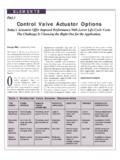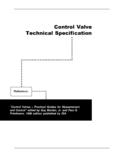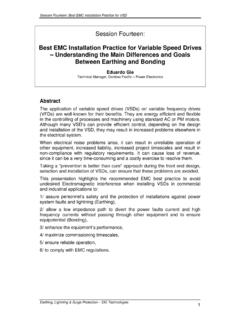Transcription of HART v FOUNDATION FIELDBUS – THE FACTS and THE REAL …
1 HART v FOUNDATION FIELDBUS THE FACTS and THE REAL DIFFERENCE Jim Russell IEng, MIMC, FIICA, Chair FFEUC-Aus, FFEUAC (Oceania) Committee Member Abstract The question is often asked Why should I install FOUNDATION FIELDBUS when the features are all available with HART? This White paper addresses this question, provides some of the answers and covers the following; The Technologies Differences, Advantages and Disadvantages Why some Manufacturers / Suppliers continue to push HART and put up a Smokescreen ? Brownfield and Greenfield Plants- What technology should be used Simple HART v FF Comparison Chart The Technologies HART Devices using HART communication technology hit the market in the early 1980s and there are around10 million HART devices in service throughout the world today.
2 HART is well proven, has a large Installed base and the technology is simple and well understood by technicians/engineers. HART Field Communications Protocol is superimposed on the 4-20mA signal and provides two way communications with smart field instruments without compromising the integrity of the measured data. HART communicates at 1200 bps and provides a host with two or more digital updates per second from a field device. Generally a single pair cable is installed for each device and the 4-20 mA signal is generally used for the Process Variable, however this parameter is also available via device digital data. Also several devices can connect in series in the same current loop, providing digital data from each device. Current in the loop stays at a constant value and in this case the PV for each device is available from the digital data. Multi-drop HART networks are used in applications where fast update rates are not required.
3 This feature is rarely used. HART is Master/Slave by design thus there can only be only two Masters eg., Control System/Hand Held. FOUNDATION FIELDBUS Devices using FOUNDATION FIELDBUS Technology became available in 1998 and there are over 700,000 FOUNDATION FIELDBUS Devices installed in over 10,000 systems. The technology is now proven and has a growing installed base FOUNDATION FIELDBUS is a true Multidrop System and has numerous advantages including: - Wiring savings - Hardware savings-fewer devices (instruments barriers and I/O) - Documentation savings-Simpler layout and drawings - Reduced Engineering costs - Footprint savings - Multi-variable field devices - Interoperability and freedom of choice - Reduced Commissioning and startup costs - Reduced downtime - Integrity improved - DCS future capacity savings - Control in the field - Device Plug and Play - On line configuration - Time Stamping and Synchronisation - Obsolescence Robustness - Status Information - Tag Search Capability - Interface to High Speed Ethernet -Trend storage in the field device - Predictive Maintenance - DCS future capacity savings - Automated data collection for asset management The Hype Don t believe all the hype given out by manufacturers.
4 Especially those that tell you that you can get everything provided by FOUNDATION FIELDBUS with HART. The FACTS - Differences, Advantages and Disadvantages Power FOUNDATION FIELDBUS has a distinct advantage when considering power availability, HART has a Power Limitation in that it has only around 35 milliwatts and 4mA available for the HART signal. FF has a minimum power requirement of 8mA with no specification limit, thus the ultimate FF limit is the H1 segment power budget. FOUNDATION FIELDBUS shares a common physical layer which provides bus power and communication for up to 32 devices over a single pair of wire. Up to 2 amps at 12 to 32 volts can be provided over this wire pair, but non-incendive installations generally limit the power to a half amp or less, and intrinsically safe installations limit current and voltage to lower levels. As a result FF devices have an order of magnitude more power available, even for Intrinsically Safe applications.
5 In regard to advances in silicon power consumption ie., processor power, these will be the same for HART or FF thus FF will always have capability for more functionality. Communication Performance The slow HART baud rate of 1200 bits per second puts an additional burden on the control system, in that it takes a long time to ask 1000 or 2000 instruments how they feel . FF H1 communicates at 31,250 bits/sec thus communication performance is demonstrably better than HART Transmitter Diagnostics HART technology has the ability to provide diagnostics for the device only, this includes any predictive options. Thus HART has no knowledge of other devices. FF however communicates with other devices, opening a whole new potential in regards to advanced diagnostics such as plant health systems. Many basic device diagnostics are a result of HART legacy. For both HART and FF you will hear all about the wonderful transmitter diagnostics which can tell you every little thing about the status of the transmitter.
6 Whilst this is useful for commissioning activities, generally transmitters are so reliable these days that the information is rarely accessed and used. These diagnostics are really a throwback to the days when transmitters were unreliable and the information was thus extremely useful. As a result we have a huge diagnostic database of what is pretty useless information. Manufacturers found it easy to just macro across the existing HART diagnostics to FF and thus it is the installed HART base which is holding back the potential of FF, as diagnostics in the field devices are rather primitive compared to what is possible. HART technology is so limited on power and communication capability that advanced diagnostics have not been possible and even simple memory checks have been run as a very slow background task (every 20 minutes). Today, FOUNDATION FIELDBUS provides more power and communication, but most vendors have a strong economic incentive to leverage their device development across multiple platforms.
7 The least common denominator has won out in many implementations and diagnostics for many vendors is the same in all busses. The FOUNDATION FIELDBUS capability to support diagnostics has been largely unexploited. Only in the last couple of years have manufacturers started a real program to accelerate diagnostics development in FF devices. Some other vendors are concentrating most of their diagnostics development in application host computers that run on top of an OPC server for field data. Most of these applications are designed to run at very low rates with slow data update. The data update is typically at historian update frequency, and the applications may run on a schedule from every few hours to every few days. Some run only on demand. Pushing these diagnostics down into field devices can provide much improved diagnostic capability in that the diagnostics can run continuously with a high data update rate (20 to 100 Hz).
8 This high rate can measure problems that will not be observable with the app node technology. This high data rate processing in field devices is the focus of current Research and Development, and is the basis for use of FOUNDATION FIELDBUS for advanced diagnostics. App node diagnostic technology is likely to be developed further and will serve the legacy HART installed base market. Advanced Diagnostics Whilst you will get some vendors telling you that some HART devices provide advanced diagnostics, these will be much more limited than those available through FF. HART does not have the processing power to provide the capability to mirror FF and also is of course constrained in that any diagnostics can only be associated with the specific device. The fact that FF gives the ability to communicate across devices enables more complex applications such as Statistical Process Monitoring and Machinery Health monitoring.
9 These diagnostics use complex maths and thus a HART based device does not have the electrical power necessary to do the number crunching required. The Future capabilities of FF advanced diagnostics are huge with potential for self validating transmitters, valves, relief valves etc. If a legacy system is installed these features will not be available. Push versus Poll HART transmitters are polled for HART status periodically whereas FOUNDATION FIELDBUS devices push. Thus HART transmitters can potentially miss field intermittent problems. A typical example of this is where a company had moisture in transmitters causing intermittent problems. In the HART system the status bit set and then cleared. Polling missed the bit as it was being set and cleared and thus the problem was not detected. With FF, devices push with events latched and time stamped in the device. The event is then sent to the host.
10 There is no chance of missing field problems with FF. Multidrop Capability HART provides a single pair of wire to each field device and powers the device over the 4 to 20 ma signal current. HART has a very limited digital only capability and a theoretical limit of 15 devices, however it is practically only about 3 because of the slow SERIES loop. FF is a true multidrop technology with a theoretical limit 32 devices which is practically 12-16. Furthermore FISCO, FNICO and High Power Trunk concepts have radically changed the number of instruments that can be installed in Ex environments. Use in Safety Instrumented Systems Presently HART is the only option and all devices are wired individually. This is one of the key decision makers in brownfield plants staying with HART ie., the same technology across the plant. The FIELDBUS FOUNDATION is working on FF safety systems, however it needs a very robust approach.









